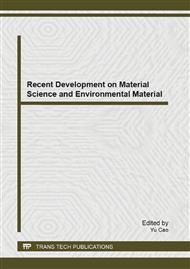[1]
F. Hao, K.J. Davey, W.J. Bruckard , J.T. Woodcock. Online analysis for xanthate in laboratory flotation pulps with a UV monitor[J]. International Journal of Mineral Processing 89(2008)71–75.
DOI: 10.1016/j.minpro.2008.07.004
Google Scholar
[2]
M.B. Kasiri, H. Aleboyeh, A. Aleboyeh, Degradation of Acid Blue 74 using Fe-ZSM5 zeolite as a heterogeneous photo-Fenton catalyst[J]. Applied Catalysis B: Environmental 84 (2008) 9–15.
DOI: 10.1016/j.apcatb.2008.02.024
Google Scholar
[3]
A. Durán, J.M. Monteagudo, E. Amores, Solar photo-Fenton degradation of Reactive Blue 4 in CPC reactor[J]. Applied Catalysis B: Environmental 80 (2008) 42–50.
DOI: 10.1016/j.apcatb.2007.11.016
Google Scholar
[4]
[ N.K. Daud, M.A. Ahmad, B.H. Hameed. Decolorization of Acid Red 1 dye solution by Fenton-like process using Fe–Montmorillonite K10 catalyst 2 Materials and methods, Chemical Engineering Journal 165 (2010) 111–116.
DOI: 10.1016/j.cej.2010.08.072
Google Scholar
[5]
C.P. Huang, C. Dong, Z. Tang, Advanced chemical oxidation: its present role and potential future in hazardous waste treatment, Waste Manage 13 (1993)361–377.
DOI: 10.1016/0956-053x(93)90070-d
Google Scholar
[6]
L.C.A. Oliveira, M. Goncalves, M.C. Guerreiro, T.C. Ramalho, J.D. Fabris, M.C. Pereira, K. Sapag, A new catalyst material based on niobia/iron oxide composite on the oxidation of organic contaminants in water via heterogeneous Fenton mechanisms, Applied catalysis A: General 316 (2007).
DOI: 10.1016/j.apcata.2006.09.027
Google Scholar
[7]
N.K. Daud, B.H. Hameed. Fenton-like oxidation of reactive black 5 solution using iron–Montmorillonite K10 catalyst[J]. Journal of Hazardous Materials 176 (2010) 1118–1121.
DOI: 10.1016/j.jhazmat.2009.11.134
Google Scholar
[8]
Q. K Hu, J. Wu, Z.L. Deng. Study on Fe2+/NaClO Reagent Treating Cresol Wastewater [J]. Shanghai Chemical Industry 32(2007)14-16.
Google Scholar
[9]
E. Chamarro, A . Marco. Use of Fenton reagent to improve organic chemical biodegradability [J]. Water Research 35(2001)1047-1051.
DOI: 10.1016/s0043-1354(00)00342-0
Google Scholar
[10]
X.S. Zhong and W. Forsling. The degradation kinetics of ethyl-xanthate as a function of pH in aqueous solution [J]. Minerals Engineering 10(1997)389-400.
DOI: 10.1016/s0892-6875(97)00016-2
Google Scholar
[11]
S.H. Chen, W.Q. Gong, G.J. Mei, W.Y. Han. Anaerobic biodegradation of ethylthionocarbamate by the mixed bacteria under various electron acceptor conditions [J]. Bioresource Technology 102(2011)10772-10775.
DOI: 10.1016/j.biortech.2011.09.030
Google Scholar


